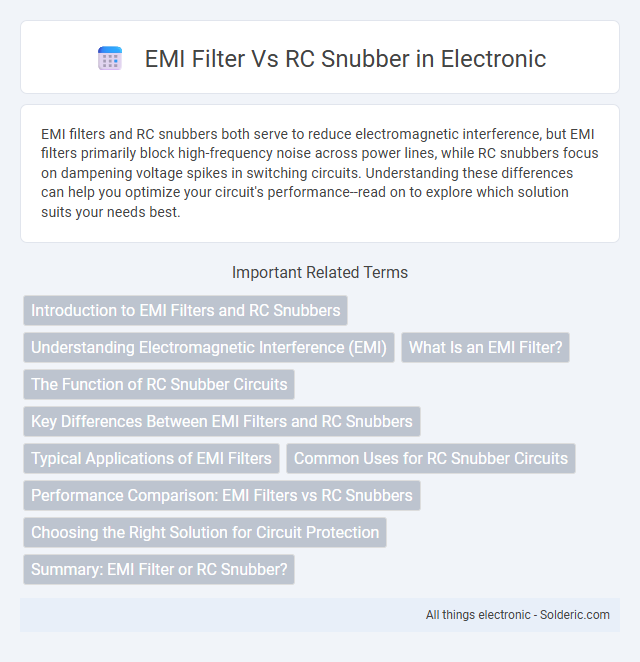EMI filters and RC snubbers both serve to reduce electromagnetic interference, but EMI filters primarily block high-frequency noise across power lines, while RC snubbers focus on dampening voltage spikes in switching circuits. Understanding these differences can help you optimize your circuit's performance--read on to explore which solution suits your needs best.
Comparison Table
| Feature | EMI Filter | RC Snubber |
|---|---|---|
| Primary Function | Suppress electromagnetic interference (EMI) in power lines | Reduce voltage spikes and ringing in switching devices |
| Components | Inductors, capacitors, sometimes resistors | Resistor and capacitor connected in series |
| Application | Used in power supplies, motors, electronic circuits | Used across switches, transistors, MOSFETs in power electronics |
| Frequency Range | Broadband suppression (kHz to MHz) | High-frequency transient suppression |
| Effectiveness | Reduces conducted and radiated EMI | Limits voltage spikes, reduces switching noise |
| Installation Position | Input or output power lines | Across switching device terminals |
| Power Dissipation | Generally low | Moderate to high, depends on spike energy |
| Cost | Higher due to multiple components | Lower, simple resistor and capacitor |
| Design Complexity | Complex design for optimal EMI reduction | Simple design focused on transient absorption |
Introduction to EMI Filters and RC Snubbers
EMI filters and RC snubbers both serve to mitigate electromagnetic interference in electronic circuits, but they operate differently and target specific interference types. EMI filters primarily block high-frequency noise from entering or exiting electronic equipment through power lines, using inductors and capacitors to suppress unwanted signals. Your choice between an EMI filter and an RC snubber depends on the nature of the interference, with RC snubbers specifically designed to reduce voltage spikes and ringing caused by switching devices.
Understanding Electromagnetic Interference (EMI)
EMI filters are designed to suppress electromagnetic interference by blocking high-frequency noise from power lines and equipment, ensuring signal integrity and compliance with EMC standards. RC snubbers protect circuits from voltage spikes and reduce high-frequency oscillations by dissipating transient energy through resistor-capacitor networks, targeting specific switching noise. Your choice between EMI filters and RC snubbers depends on the type of interference and whether you need broadband noise suppression or localized transient spike protection.
What Is an EMI Filter?
An EMI filter is a device designed to suppress electromagnetic interference (EMI) by blocking high-frequency noise signals while allowing desired electrical signals to pass through. Compared to an RC snubber, which primarily absorbs voltage spikes to protect circuits, an EMI filter offers broader noise reduction across a wide frequency range, improving overall system electromagnetic compatibility (EMC). You can enhance your electronic system's performance by integrating an EMI filter to minimize interference from external sources and reduce emitted noise.
The Function of RC Snubber Circuits
RC snubber circuits protect semiconductor devices by suppressing voltage spikes and dampening transient oscillations in power electronics. They absorb energy from inductive loads during switching events, reducing electromagnetic interference (EMI) and preventing damage to components. Unlike EMI filters that primarily block conducted noise, RC snubbers specifically manage switching transients to enhance circuit reliability and longevity.
Key Differences Between EMI Filters and RC Snubbers
EMI filters primarily reduce electromagnetic interference by attenuating high-frequency noise in power lines using inductors and capacitors, whereas RC snubbers protect semiconductor devices from voltage spikes and dampen transient oscillations using a resistor-capacitor network. EMI filters are designed for continuous noise suppression across a broad frequency range, while RC snubbers target specific transient events and energy absorption in switching circuits. The effectiveness of EMI filters depends on their insertion loss and frequency response, whereas RC snubbers focus on controlling voltage overshoot and ringing in switching devices.
Typical Applications of EMI Filters
EMI filters are commonly used in power supplies, industrial equipment, and audio devices to reduce electromagnetic interference and ensure compliance with regulatory standards. They effectively suppress high-frequency noise generated by switching devices, motors, and communication lines. If you need to protect sensitive electronics or enhance signal integrity, incorporating an EMI filter is essential for maintaining optimal performance.
Common Uses for RC Snubber Circuits
RC snubber circuits are commonly used to protect electronic components from voltage spikes and to reduce electromagnetic interference (EMI) generated by switching devices like transistors and relays. These circuits are essential in power electronics to suppress transient voltages and improve device reliability in inductive load switching. Your equipment benefits from RC snubbers by minimizing stress on components and enhancing overall operational stability.
Performance Comparison: EMI Filters vs RC Snubbers
EMI filters provide superior attenuation of high-frequency electromagnetic interference by utilizing inductors and capacitors to block unwanted noise across a broad frequency range, ensuring cleaner power signals. RC snubbers primarily protect circuits from voltage spikes and transient surges by dissipating energy through a resistor-capacitor network, effectively reducing ringing and switching stresses but offering limited broadband EMI suppression. For your applications requiring comprehensive noise reduction and compliance with EMC standards, EMI filters generally deliver better overall performance compared to RC snubbers.
Choosing the Right Solution for Circuit Protection
EMI filters are ideal for suppressing high-frequency electromagnetic interference and improving signal integrity in sensitive electronic circuits. RC snubbers effectively protect switching devices from voltage spikes and transient surges, enhancing component lifespan and reliability. Selecting between EMI filters and RC snubbers depends on whether the primary concern is noise reduction or transient voltage protection in the circuit.
Summary: EMI Filter or RC Snubber?
EMI filters are designed to suppress electromagnetic interference across a broad frequency range by attenuating noise signals using inductors and capacitors, making them ideal for compliance with regulatory standards. RC snubbers primarily protect switching devices from voltage spikes and high-frequency transient disturbances by dissipating energy through resistors and capacitors in specific circuits. Choosing between an EMI filter and an RC snubber depends on whether the goal is noise reduction for system-wide electromagnetic compatibility or transient suppression for device protection in power electronics.
EMI filter vs RC snubber Infographic

 solderic.com
solderic.com